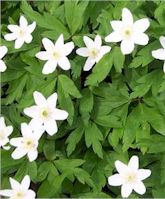 |
The Wood Anemone, or medicinal English Pulsatilla, with its lovely pink white petals, and drooping blossoms, is one of our best known and most beautiful spring flowers. Herbalists do not distinguish it virtually from the silky-haired Anemone Pulsatilla, which medicinal variety is of highly valuable modern curative use as a Herbal Simple. The active chemical principles of each plant are "anemonin" and "anemonic
acid." A tincture is made (H.) with spirit of wine from the entire plant, collected when in flower. This tincture is remarkably beneficial in disorders of the mucous membranes, alike of the respiratory and of the digestive passages. For mucous indigestion following a heavy or rich meal the tincture of Pulsatilla is almost a specific remedy. Three or four drops thereof should be given at once with a tablespoonful of water,
hot or cold, and the same dose may be repeated after an |
hour if then still needed. For catarrhal affections of the eyes and the ears, as well as for catarrhal diarrhea, the tincture is very serviceable; also for female monthly difficulties its use is always beneficial and safe. As a medicine it best suits persons of a mild, gentle disposition, and of
a lymphatic constitution, especially females; it is less appropriate for quick, excitable, energetic men.
Anemonin, or Pulsatilla Camphor, which is the active principle of this plant, is prepared by the chemist, and may be given in doses of from one fiftieth to one tenth of a grain rubbed up with dry sugar of milk. Such a dose (or a drop of the tincture with a tablespoonful of water), given every two or three hours, will soon relieve a swollen testicle; and the tincture still more diluted will ease the bladder difficulties of old men.
Furthermore, the tincture, in doses of two or three drops with a spoonful of water, will allay spasmodic cough, as of whooping cough, or bronchitis. The vinegar of Wood Anemone made from the leaves retains all the more acrid properties of the plant, and is put, in France, to many rural domestic purposes. When applied in lotions every night for five or six times consecutively, it will heal indolent ulcers; and its rubefacient effects serve
instead of those produced externally by mustard. If a teaspoonful is sprinkled within the palms and its volatile vapors are inhaled through the mouth and nose, this will dispel an incipient catarrh. The name Pulsatilla is a diminutive of the Latin puls, a pottage, as made from pulse, and used at sacrificial feasts. The title Anemone signifies "wind-flower." Pliny says this flower never opens but when the wind is blowing. The title
has been misapprehended as "an emony." Turner says gardeners call the flowers "emonies"; and Tennyson, in his "Northern Farmer," tells of the dead keeper being found "doon in the woild enemies afoor I corned to the plaice." Other names of the plant are Wood Crowfoot, Smell Fox (Rants), and Flawflower. Alfred Austin says, "With windflower honey are my tresses smoothed." It is also called the Passover Flower, because blossoming at
Easter; and it belongs to the Ranunculaceous order of plants. The flower of the Wood Anemone tells the approach of night, or of a shower, by curling over its petals like a tent; and it has been said that fairies nestle within, having first pulled the curtains round them. Among the old Romans, to gather the first Anemone of the year was deemed a preservative against fever. The Pasque flower, also named Bluemoney and Easter, or Dane's flower,
is of a violet blue, growing in chalky pastures, and less common than the Wood Anemone, but each possesses equally curative virtues.
The seed of the Anemone being very light and downy, is blown away by the first breeze of wind. A ready-witted French senator took advantage of this fact while visiting Bacheliere, a covetous florist, near Paris, who had long held a secret monopoly of certain richly-colored and splendidly handsome anemones from the East. Vexed to see one man hoard up for himself what ought to be more widely distributed, he walked and talked with the florist
in his garden when the anemone plants were in seed. Whilst thus occupied, he let fall his robe, as if by accident, upon the flowers, and so swept off a number of the little feathery seed vessels which clung to his dependent garment, and which he afterwards cultivated at home. The petals of the Pasque flower yield a rich green color, which is used For staining Easter eggs, this festival having been termed Pask time in old works, from "paske,"
a crossing over. The plant is said to grow best with iron in the soil.
Herb Simples
The Primitive Simplers presented here show the way of life in other generations, it is not suggested or recommended trying them yourself. |


